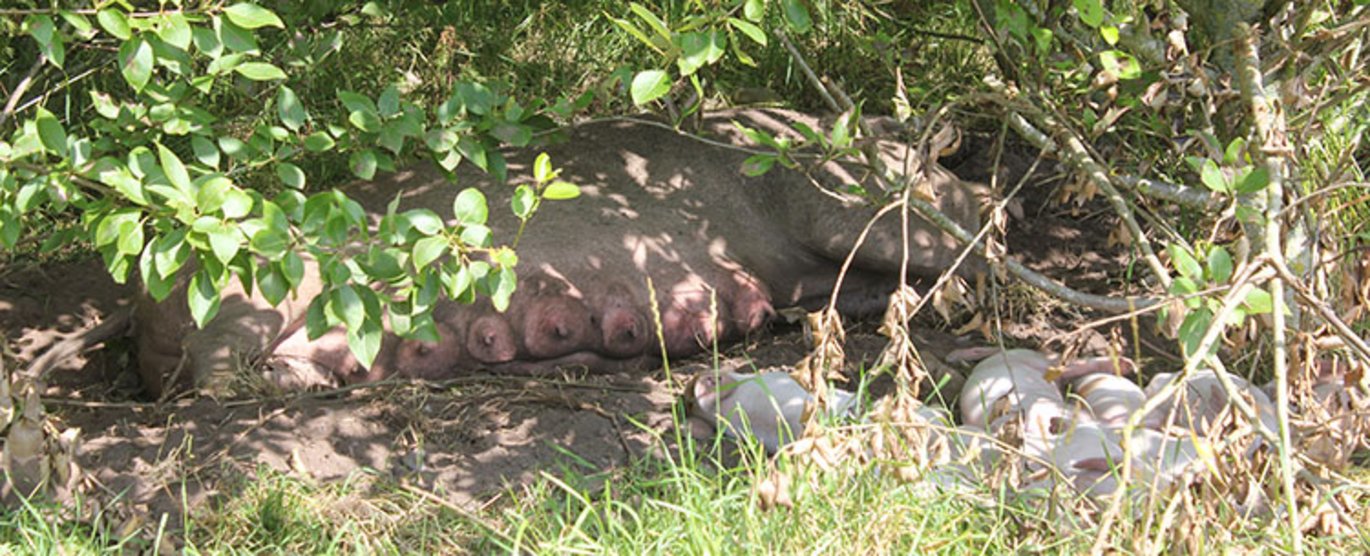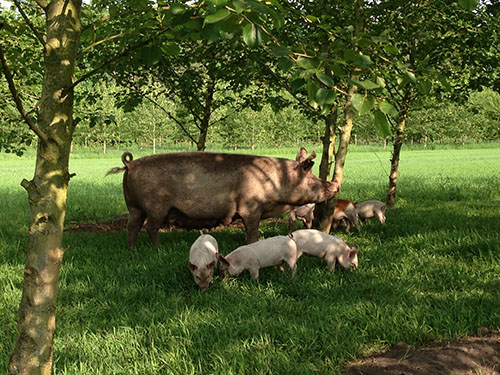Shade for outdoor pigs is important
Sows in a pasture-based system are facing animal welfare challenges, as the only possibility to seek protection from the sun is the farrowing hut. Inclusion of trees in these systems reduces the heat load of the sows during hot periods.

Temperatures above 30 degrees Celsius have been recorded inside farrowing huts. In comparison, the lactating sow’s comfort temperature is between 12-22 degrees Celsius. From indoor systems, it is well-known that heat stress has a negative impact on piglet survival and can be assumed to have similar negative effects in outdoor production systems. In addition to the negative consequences on piglet survival, we recently became aware of high incidences of sows with sunburned ears in pasture-based systems. As a rule of thumb, pigs have similar sensibility to pain as humans. Therefore, severe sunburn is expected to inflict pain in the pig.
Inclusion of trees in pasture-based systems reduces heat load of sows
Preliminary results show that sows, lying in the shade of poplar trees, had a lower respiration frequency compared to sows lying inside the hut (30 and 45 breaths per 60 seconds, respectively). Furthermore, at increasing temperature sows with access to trees spent more time outside the hut, compared to sows with no access to trees. Another consequence of heat stress can be prolonged farrowings, which may increase piglet mortality. An investigation of the consequences of heat stress on the farrowing process is the next step in the Organic RDD2 project ‘VIPiglets’.
Regarding sunburn, no clear effect of inclusion of trees was found on the frequency of sunburned ears. This may be due to sows with no access to trees spending more time inside the hut compared to sows with access to trees. The hut will - as the trees - protect sows against the sun, but not reduce the heat load. Another reason why no effect was seen may be that the trees, in the two studies mentioned, were located some distance from the farrowing hut. As sows are motivated to stay near their piglets, and therefore also near the hut, in the first week after farrowing, they may not have used the trees during this period. Thus, to optimize the effect of trees, the farrowing hut should be located relatively close to the trees.
Apart from providing shade, trees also have a positive effect on the environment and offer additional enrichment to the sows in the paddocks. The environmental effects of implementing tress in the paddocks are investigated in the Organic RDD2 project ‘pECOSYSTEM’.
The piglets follow the sow into the shade and thereby avoid getting sunburned.
Requirement for provision of shade - included in The Danish Organic Code of Practice
Danish organic farmers have indeed embraced the issue concerning sows´ need for shade, since recently a requirement for provision of shade has been included in the Danish Organic Code of Practice. Farmers are working on alternative solutions to provide shade for the sows, e.g. setting up a sun sail across the farrowing hut or adding a shed roof to the farrowing hut. The challenge is to find a solution, which prevents heat stress and can be handled in practice. So far, the Code of Practice focuses on lactating sows, as they are the ones most prone to heat stress. However, in the future it will be an advantage also to include requirements for shade in paddocks with pregnant sows.
Currently, general legislation for outdoor pigs state that pigs must have access to a wallow when the temperature exceeds 15 degrees Celsius in the shade. Wallowing provides a high heat loss as opposed to shade. Thus, by providing shade in the paddocks, pigs have a better opportunity to thermoregulate: If the temperature is only slightly above or in the upper part of the sows’ comfort temperature, sows can seek shade and at higher temperatures, they can wallow. Furthermore, by seeking shade after wallowing the cooling effect is increased, as compared to a scenario where sows are restricted to stay in the sun or the hut after wallowing. Therefore, there are different solutions for different temperatures – shade and wallows are not a replacement for one another. An additional benefit of shade is that the piglets follow the sow into the shade - so the shade lowers the risk of piglets getting sunburned.
The projects pECOSYSTEM and VIPiglets are part of the Organic RDD 2 programme, coordinated by ICROFS (International Centre for Research in Organic Food systems). Both projects have received grants from the Green Development and Demonstration Program (GUDP) under the Environment and Food Ministry.
